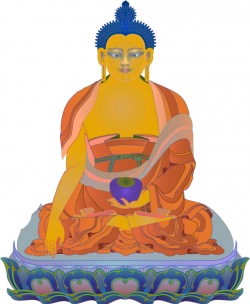Āyatana
- See also:Ayatana
1. 'spheres', is a name for the four immaterial absorptions; s. jhāna (5-8).
2. The 12 base' or 'sources' on which depend the mental processes, consist of five physical sense-organs and consciousness, being the six personal bases (ajjhattika); and the six external objects, the so-called external (bāhira) bases - namely:
- eye, or visual organ visible object
- ear, or auditory organ sound, or audible object
- nose, or olfactory organ odour, or olfactive object
- tongue, or gustatory organ taste, or gustative object
- body, or tactile organ body-impression, or tactile object
- mind-base, or consciousness mind-object (manāyatana) (dhammāyatana)
"By the visual organ (cakkhāyatana) is meant the sensitive part of the eye (cakkhu-pasāda) built up of the four elements ... responding to sense-stimuli" (sa-ppatigha).... (Vibh. II). Similar is the explanation of the four remaining physical sense-organs.
Mind-base (manāyatana) is a collective term for all consciousness whatever, and should therefore not be confounded with the mind-element (mano-dhātu; s. dhātu II,
16), which latter performs only the functions of adverting (āvajjana) to the sense-object, and of receiving (sampaticchana) the sense-object. On the functions of the mind, s. viññāna-kicca.
The visible object (rūpāyatana) is described in Vibh. II as "that phenomenon which is built up of the four physical elements and appears as color, etc."
What is' seen by-visual perception, i.e. by eye-consciousness (cakkhu-viññāna) are colors and differences of light, but not three dimensional bodily things.
'Mind-object-base' (dhammāyatana) is identical with 'mind-object-element' (dhamma-dhātu; s. dhātu II) and dhammārammana (s. ārammana).
It may be physical or mental, past, present or future, real or imaginary.
The 5 physical sense-organs are also called faculties (indriya), and of these faculties it is said in M. 43:
"Each of the five faculties owns a different sphere, and none of them partakes of the sphere of another one; ... they have mind as their support... are conditioned by vitality, ... but vitality again is conditioned by heat, heat again by vitality, just as the light and flame of a burning lamp are mutually conditioned."
The 12 bases are fully discussed in Vis.M. XV. In Yam III (s Guide, p 98f) the 12 terms are subjected to a logical investigation The six personal bases form the 5th link of dependent origination (paticca-samuppāda 5).
āyatana: 1. 'spheres', is a name for the four immaterial absorptions; s. jhāna (5-8). āyatana : [nt.] sphere; region; sense-organ; position.
2. The 12 'bases' or 'sources' on which depend the mental processes, consist of five physical sense-organs and consciousness, being the six personal (ajjhattika) bases; and the six objects, the so-called external (bāhira) bases - namely:
1. eye, or visual organ visible object
2. ear, or auditory organ sound, or audible object
3. nose, or olfactory organ odour, or olfactive object
4. tongue, or gustatory organ taste, or gustative object
5. body, or tactile organ body-impression, or tactile object
6. mind-base, or consciousness mind-object (manāyatana) (dhammāyatana)
"By the visual organ (cakkhāyatana) is meant the sensitive part of the eye (cakkhu-pasāda) built up of the four elements ... responding to sense-stimuli" (sa-ppaṭigha).... (Vibh. II).
Similar is the explanation of the four remaining physical sense-organs.
Mind-base (manāyatana) is a collective term for all consciousness whatever, and should therefore not be confounded with the mind-element (mano-dhātu; s. dhātu II, 16), which latter performs only the functions of adverting (āvajjana) to the sense-object, and of receiving (sampaṭicchana) the sense-object.
On the functions of the mind, s. viññāṇa-kicca.
The visible object (rūpāyatana) is described in Vibh. II as "that phenomenon which is built up of the four physical elements and appears as color, etc."
What is' seen by-visual perception, i.e. by eye-consciousness (cakkhu-viññāṇa) are colors and differences of light, but not three dimensional bodily things.
'Mind-object-base' (dhammāyatana) is identical with 'mind-object-element' (dhamma-dhātu; s. dhātu II) and dhammārammaṇa (s. ārammaṇa).
It may be physical or mental, past, present or future, real or imaginary.
The 5 physical sense-organs are also called faculties (indriya, q.v.), and of these faculties it is said in M. 43: "Each of the five faculties owns a different sphere, and none of them partakes of the sphere of another one; ... they have mind as their support... are conditioned by vitality, ... but vitality again is conditioned by heat, heat again by vitality, just as the light and flame of a burning lamp are mutually conditioned."
The 12 bases are fully discussed in Vis.M. XV. In Yam III (s Guide, p 98f) the 12 terms are subjected to a logical investigation The six personal bases form the 5th link of dependent origination (paṭiccasamuppāda 5, q.v.).
āyatana (Sanskrit).
In Buddhist psychology, the twelve āyatanas are the six senses or modes of perception and the six kinds of object they correspond to, namely:
(1) sight and colour/form (rūpa-āyatana);
(2) hearing and sound (śabda-āyatana);
(3) smell and scent (gandha-āyatana);
(4) taste and flavours (rasa-āyatana);
(5) touch and tangible objects (sparśa-āyatana); and
(6) mind and ideas (mano-āyatana).
Each āyatana is thus the sphere or domain of a particular sense, and encompasses everything that can be experienced through that particular ‘sense-door’. See also ṣad-āyatana.
Āyatana (nt.) [Sk. āyatana, not found in the Vedas; but freq. in BSk. From ā + yam, cp. āyata. The pl. is āyatanā at S iv.70. -- For full definition of term as seen by the Pāli Commentators see Bdhgh's expln at DA i. 124, 125, with which cp. the popular etym. at KhA 82: "āyassa vā tananato āyatassa vā saŋsāradukkhassa nayanato āyatanāni" and at Vism 527 "āye tanoti āyatañ ca nayatī ti ā."] --
1. stretch, extent, reach, compass, region; sphere, locus, place, spot; position, occasion (corresponding to Bdhgh's definition at DA i.124 as "samosaraṇa")
D iii.241, 279 (vimutti˚); S ii.41, 269; iv.217; v.119 sq., 318. sq.; A iii.141 (ariya˚); v.61 (abhibh˚, q. v.) Sn 406 (rajass˚ "haunt of passion" = rāgādi -- rajassa uppatti -- deso SnA 381); J i.80 (raj˚). Freq. in phrase araññ˚ a lonely spot, a spot in the forest J i.173; VvA 301; PvA 42, 54. -- 2. exertion, doing, working, practice, performance (comprising Bdhgh's definition at DA i.124 as paññatti), usually -- ˚, viz. kamm˚ Nd1 505; Vbh 324, 353; kasiṇ˚ A v.46 sq., 60; Ps i.28; titth˚ A i.173, 175; Vbh 145, 367; sipp˚ (art, craft) D i.51; Nd2 505; Vbh 324, 353; cp. an˚ non --
exertion, indolence, sluggishness J v.121. -- 3. sphere of perception or sense in general, object of thought, sense -- organ & object; relation, order. --
Cpd. p. 183 says rightly: "āyatana cannot be rendered by a single English word to cover both sense -- organs (the mind being regarded as 6th sense) and sense objects". --
These āyatanāni (relations, functions, reciprocalities) are thus divided into two groups, inner (ajjhattikāni) and outer (bāhirāni), and comprise the foll.:
(a) ajjhatt˚:
1. cakkhu eye,
2. sota ear,
3. ghāna nose,
4. jivhā tongue,
5. kāya body,
6. mano mind;
(b) bāh˚:
1. rūpa visible object,
2. sadda sound,
3. gandha odour,
4. rasa taste,
5. phoṭṭhabba tangible object,
6. dhamma cognizable object.
-- For details as regards connotation & application see Dhs trsl. introduction li sq. Cpd. 90 n. 2; 254 sq. -- Approximately covering this meaning (3) is Bdhgh's definition of āyatana at DA i.124 as sañjāti and as kāraṇa (origin & cause, i. e. mutually occasioning & conditioning relations or adaptations)




